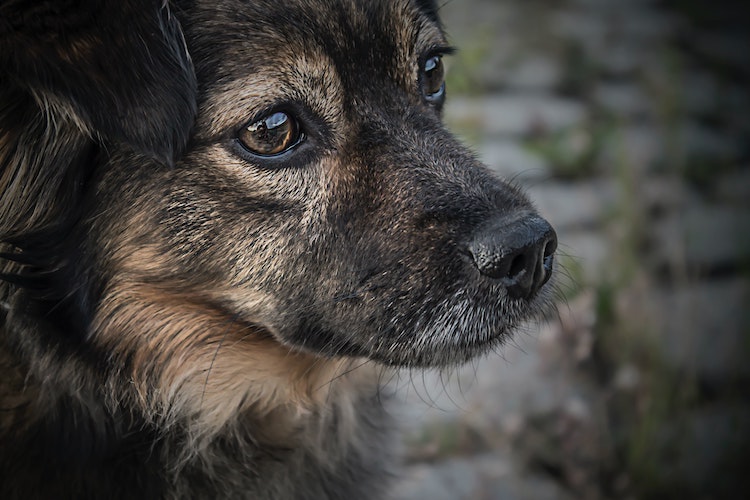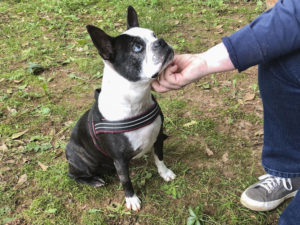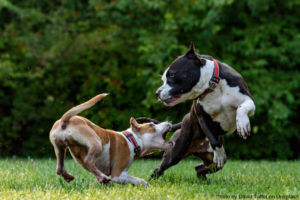You just brought home a scared and frightened foster dog. Maybe you’ve adopted a fearful dog and you feel a little overwhelmed. Your dog is scared of everything. You can’t get the dog to come out of hiding or the dog is too afraid to go outside to pee.
Maybe you are afraid you took on more than you could handle. Can we help a fearful dog? How can you train your fearful dog to trust you?
I have help for you! Fearful dogs can recover, gain confidence, and form a bond with you. If you are fostering a fearful dog, those gains can transfer to a new human in an adoptive home.
I am not a veterinarian nor an animal behaviorist. I present my understanding of health or behavior issues based on personal experience and research I’ve done. If you have a dog with a health or behavioral issue, seek professional guidance. I hope you find my post useful.
Before we get into the whys and hows, I want to encourage you right here: establish fair expectations, both for you and this scared rescue dog you are wanting to help.
For the dog, love them right where they are. Accept their behavior, with all the fear and anxiety and resistance to your care while working to help them overcome their fear. They are not choosing to be afraid and they do not know how to feel better, or they would.
Right?
For you, find patience and some zen. This isn’t a race, and your fearful dog’s seemingly slow progress is no reflection on your efforts. Often things will feel “two steps forward, three steps back”.
Think of this journey as a dance. Two beings forming a relationship that moves in sync, one step at a time, changing directions as dictated by the dance. Sometimes, your fearful dog will move in sync with you, often, you will need to move with your dog as they are not ready to go where you lead.
What Are The Signs Of A Fearful Dog?
Fear in a dog is a wide topic. Some dogs have specific fears like of an object or a sound. Some dogs are afraid of other animals or of certain people. Or people who wear hats. Or your phone dinging with every text message.
One of my dogs was afraid of only men who entered my backyard through the garden gate. She would attack their feet. Help for my fearful dog required one little change: I began to ask male contractors to come through my front door so she’d relax. She was happy to greet them appropriately at the front door.
These are all important types of fear. But today I’m writing about fear in a dog so profound it impacts your ability to provide basic care needs.
These fearful dogs may
- hide under the bed or in a closet or other small space, such as a crate.
- refuse to come out of their crate or hiding place, even to use the bathroom.
- avoid human touch
- appear depressed
- be scared to go outside or come inside
- refuse to walk on a leash
- not let you put a collar or leash on them
- refuse to eat/drink anything
- will not pee outside
- try to run away
- act aggressive by growling, showing teeth, or even snapping at you
I know a little about how to help a fearful dog, but I know the professionals know a lot about how to help a fearful dog. I wanted some weigh-in to give you the best information I can.
I contacted *Paula Nowak, CPDT-KA, CNWI, CTDI who graciously agreed to talk with me about fearful dogs and how we can help these dogs become less fearful and develop a better relationship with humans. She is head trainer, behavioral consultant, and owner of Canine Country Academy in Lawrenceville, GA.
Nature vs Nurture
We started our conversation by talking about the origins of fearful behavior in dogs.
I asked Paula, “What causes a dog to become fearful? Is it safe to assume that all fearful dogs have experienced abuse or neglect, or is fear genetic?”
“Both.” She said. “Nature vs Nurture, right?” She explained that genetics play an important role in a dog’s interaction with the world. Equally influential is a dog’s early development, learning, and socialization.
In other words, genetics can predispose a dog to developing fearful responses. Likewise, abuse/neglect/absence of learning can influence the development of a fearful dog.
Many rescued “puppy mill” dogs struggle, not because they experienced physical abuse, but because they didn’t experience much of anything. They moved from a world that was the size of their cage to a huge world with too much new.
Some dogs experience awful things and come away seemingly unaffected.
Some dogs received loving, good care and develop fear anyway.
The Backstory – Was My Fearful Dog Abused?
In rescue circles, we often talk about one of our foster dogs in terms of the dog’s history or “back story.” Where did this dog come from? How did it end up in rescue? What happened to this scared dog to cause it to behave the way it behaves?
Often, in the absence of history, we’ll make something up that seems to explain the dog’s fearful behavior. For example, we quickly assume that if a dog behaves fearfully when you bring out a broom, that dog MUST have been swatted with a broom.
Our heart hurts to see a dog so scared. We feel better when we have something/someone to blame.
Truth is, the dog may have never seen a broom before and that new object is the source of the fear, not a history of being hit by one.
How important is the backstory when helping a fearful dog?
So I wanted to know how important is the back story? Does knowing or not knowing influence how we help a fearful dog recover?
Paula says, “If the history is there, great! It’s more knowledge about the dog and I use it.” If there’s no back story, it isn’t a barrier to helping the fearful dog recover.
The super important message is – don’t use a back story to provide a reason to just let a fearful dog live in fear. “Well, she’s a puppy mill dog, she is who she is” is a shhh…. poor excuse for not helping a fearful dog experience less fear.
Take away points:
- Both genetics and life experiences influence a dog’s response to their world.
- If you have access, a “back story” can be helpful but isn’t necessary in formulating a care plan for a fearful dog.
- Regardless of a fearful dog’s past, provide them with help to recover. Don’t excuse away their behavioral responses as irreparable because of their presumed history.
How To Help A Fearful Dog
So, how do we help a fearful dog? Where do we start? What do we do? What if what we are doing isn’t working? Will our fearful dog ever be normal?
A Bit About The 3-3-3 Rule
I see at least one social media post a day, “My rescue dog is hiding under the bed and won’t come out, what do I do?” and someone will post the 3-3-3 rule graphic.
(Get The 3-3-3 Rule Graphic Here)
What’s the 3-3-3 rule? It’s a brief synopsis of a new dog’s adjustment timeline into your home.
Basically it says, it takes about 3 days for a new dog to get their bearings, 3 weeks for them to feel oriented to your schedule and lifestyle and begin to show more of their personality, and 3 months for them to feel settled.
Bottom line: the 3-3-3 rule isn’t a rule at all. “It isl a guide for your new dog’s potential.” says Paula. Your fearful dog probably won’t follow the 3-3-3 rule and you shouldn’t expect them to.
It might take weeks for your scared dog to warm up to you whereas it would take a well-adjusted dog less than three days.
Working With A Scared or Fearful Rescue Dog
What does it take to help a fearful dog? Paula and I talked about this for a while. A big part of your role as caregiver to a fearful dog is keeping tabs on your mindset. Your acceptance, patience, staying the course, and willingness to seek help will be critically important as you pour yourself into this frightened and withdrawn dog.
Paula’s advice:
DON’T DO THIS ALONE.
Paula says, “Don’t do this alone. Fearful dogs can be really hard. They can be weird. Find a support system of knowledgeable people who’ve done this before who understand what you are managing and can help.” This isn’t the time for a novice foster parent or new pet parent to tough it out alone in caring for a fearful dog.
“Don’t wait to seek professional help” Paula advises. The earlier we bring on professionals, the earlier we can get a good assessment and design a good plan. Waiting for a fearful dog to figure things out on its own isn’t the best approach.
Talk to your veterinarian or find an alternate veterinarian skilled in providing care to a fearful dog. This knowledge is essential, especially if your fearful dog is still receiving medical care such as oral and topical medications, wound care, or medicated baths. It’s hard to provide this care to a dog that doesn’t want you to touch them! We can provide good veterinary care while minimizing fear best we can.
Ask your veterinarian for referrals to veterinary behaviorists and animal behavior consultants. These professionals are experts in fear behavior. Their guidance is golden and I guarantee whatever fee they charge is incomparable to the wealth of knowledge and help you will receive.
Use Medication When Indicated
Paula is emphatic: “Please use medications if indicated.” I can hear some of you already and I know the urge to stay holistic is strong! I do talk about holistic options below. That said, if prescription medications are indicated, please be kind to your fearful dog and provide them with that relief.
That fearful dog that is hiding in the back of the closet is suffering. If you can give them a little somethin’ somethin’ to quiet the mind so they can think, process, learn, and see you with a different set of eyes, why wouldn’t you?
Learn Your Fearful Dog’s Language
Learn how dogs communicate. Dogs communicate with their eyes, ears, their mouth, head position, tail position, and body posture. Just like humans, dogs can give off subtle messages of comfort or discomfort, or those messages can be quite obvious.
The more we are able to recognize and respond to subtle communication, the more we are able to help our fearful dog.
There are many resources on dog communication available for you, so I won’t add that to this post. A great starter is the beautifully illustrated Doggie Language Book by Lili Chin.
Fearful Dogs May Be Stinky And Messy
Implications for grooming
You just picked up a tiny, terrified ball of fur from your area shelter. She moved as far back into the corner of the crate as the walls would allow. She stinks. Bad. She has dried stuff in her fur. Her toenails are too long. You are sure that if she was given a nice warm bath and a mani/pedi that she’d feel so much better. Or at least it was best to just get it out of the way now rather than wait. She needs a bath, for cryin’ out loud!
Paula suggests that we may want to wait on the bath and tolerate the stink for a little bit. Use judgment in balancing out the dog’s fear with the benefit of a good bath. Which is more important? Is it better to wait on the bath? What grooming can be done that is fear-free?
It may be too much to expect a fearful dog to understand that you are giving them a bath with all the love in your heart.
If the nails are curled back and poking into the paw pads, absolutely, those must be cut. Painful mats of fur that are pulling on the skin need to be removed. Skin infections need to be treated. Work with your veterinarian and the most compassionate and fear-free way to take care of those issues.
Implications for house-training
It can be frustrating to care for a fearful dog and try and house-train them at the same time. They don’t want to leave their kennel. They don’t want to go outside. You can’t put a leash on them or if you do they try to run away. If you get outside, they won’t pee. You bring them back in and they immediately pee on the floor. Worse, they pee and poop in their crate.
Fearful dogs, like those that may come from puppy mills or cramped environments, may eliminate where you don’t want them to. They’ve had to pee and poop where they stand their whole life. These fearful dogs don’t know how to keep their space clean, or to poop here and sleep over there.
Arrrrrrgggh!!
It.is.hard.
Manage your expectations. Paula says, “they don’t care if their environment is clean, so keep it clean for them.” In short, expect your fearful dog to soil their crate. Often. When they do, quietly clean it up. Crates that are easy to break down and clean make the process a little more bearable. Cleaning products specifically designed for pet accidents and extra bedding are necessities.
Remember. Your fearful, frightened, scared rescue dog does not want to feel this way. They don’t know how to feel any differently and no amount of love, sweet talk, and coaxing is going to make them better. What helps a fearful dog is skillful, gentle interactions, patience, a little more patience, and a solid team of experienced pros to help guide you.
Paula further recommends:
- Start a journal and write in it every day. “Write what the dog did. Write what you did and how the dog responded. Write about events of the day, the weather, activity in your home.”
You may feel like you are writing the same thing everyday, but write anyway. Written observations help you track progress, setbacks, and become a tool whereby you can continually shape your care plan for this fearful dog. - Try safe, holistic remedies. “Start these early, day one,” says Paula. These may include Adaptil (pheromone) products, (the diffuser is great!) bach flower tinctures such as Rescue Remedy or HomeoPet formulas, or even a Thundershirt. (if the dog will let you put it on) I’ve heard of a few dogs who are comforted by wearing a simple t-shirt.
Make sure that the holistic products you choose are not in conflict with any prescription medications you give the dog. Always notify your veterinarian or veterinary behaviorist of any over-the-counter remedies you are using with your fearful dog. You will need to look underneath that tee or Thundershirt to make sure the dog’s skin remains healthy. - Provide safety, comfort, and distance. Set up their environment so that they have safety, comfort, and space away from you. “Distance is your friend,” Paula says.
For example, provide your fearful dog with an enclosure (such as an x-pen) that includes a covered or partially covered crate with bedding. Take your coffee and a book and sit a distance away. This simple intervention can allow your fearful dog some choices in choosing their distance while thinking about your presence.
Play around a little with the crate type, size, and amount of crate that’s covered. I personally err on a crate that’s slightly bigger but not too big. Some dogs may not use a crate at all but will prefer a dog bed instead. Use your observation skills to determine preferences early and if the preferences are reasonable and safe, use them. (A rescued dog preferred the “safety” of crawling underneath the garden shed as his safe place. Not a reasonable choice. We needed to provide him with a different safe space.)
Paula’s idea of creating a separate side yard makes total sense. “ Set up a small side yard for your fearful dog. If you can, attach that side yard to your exit door, reducing the need for excessive handling.” This approach may help you introduce early house training without the need to attach a leash. Allow your fearful dog to hang out in their small side yard while you garden or enjoy outdoor quiet time a distance away. - Check the pressure gauge. Continually evaluate: are you putting too much pressure on this dog? On the flip side, are you putting enough pressure on this dog? Being too passive can cause a fearful pet to linger in its current state of mind. Too much pressure can also keep a dog in a fearful state of mind. Luring a fearful dog with food to come closer to you is a form of pressure.
My Fear Story
I am deathly afraid of snakes. Any snake. I’m fine but alert if they are secure in an enclosure. I’m OK (not fine) if they are 50 feet away. The sight of a loose snake with the potential to come towards me causes a spike in anxiety. The closer the snake, the higher the anxiety. I’m making an exit plan. Ya feel me?
I’ve been afraid of snakes all my life.
When I was working for a classroom of special education students, (all boys) we invited a herpetologist to class. The boys were thrilled at the opportunity to pet a snake. The boys eventually noticed that I was on the other side of the classroom, watching them. They began to encourage me to come over to pet the snake.
I was in an emotional corner; my job was to help these boys overcome some real obstacles in their lives. I really felt pressured to approach the snake. I wanted to appear brave for these boys, but I was now too close and terrified. “C’mon Miss Betsy, he won’t bite!” “He’s not slimy!” and every other encouragement they could speak to let me know that I was OK and safe.
In their mind, if I just touched the snake, all my fear would melt away.
I was red in the face. I was shaking. I stopped breathing. I reached out and touched that snake because the encouragement (pressure) was so strong. I felt sick at my stomach as the classroom erupted in cheers.
I’m no less afraid of snakes. Encouraging (pressuring) me didn’t help at all. The boys felt better, not me.
- Resist the urge to hand-feed a fearful dog. One way to keep the pressure off of your fearful dog is to not hand-feed them. If they are already not approaching you because of their fear, asking them to take a yummy treat out of your hand is pressuring them (using a form of force) to approach before they feel comfortable.
But we want the fearful dog to trust us and learn that good things (like yummy treats) come from humans, right?
Yes, but we can do that without “forcing” (pressuring) them to choose between food and feeling safe.
Read that sentence again.
Consider instead, at a distance away, tossing a treat to the dog, aiming for right at their feet or even slightly behind them. I know it sounds counterintuitive to toss food further away when we want them to come closer.
But, tossing the treat to/behind the dog helps them learn they have a choice to back up from us when feeling uncomfortable, rather than staying stuck in one place, feeling uncomfortable. We want our fearful dogs to build confidence by using good choices that make them feel less fearful, conflicted, or pressured.
- Use your social dogs as examples for your fearful dog. With your fearful dog comfortable in their personal environment (i.e. behind a baby gate or in an x-pen) and standing a distance away in eyesight of your fearful dog, hand-feed your social dogs some treats. Toss some treats away (and in the opposite direction of your fearful dog’s space) and have your social dogs approach you again and hand them more treats. Toss a treat inside your fearful dog’s space on occasion. With distance as your friend, (remember?) your fearful dog has an opportunity to maybe connect the dots and learn by watching your social dog’s experiences.
- Play “hard to get.” Gently. Paula gives another way to keep a healthy balance of pressure on our fearful dog. Remember, we want to motivate our fearful dog without adding too much pressure, or “force.”
“Play hard to get” Paula says. Be present but quiet, use “less is more” in your interactions, and give your fearful dog the opportunity to move towards you on their own.
This is tough sometimes. It goes against our nurturing self. We’d much rather sit close to the crate or x-pen and continually sweet-talk our fearful dog into finally relaxing and letting us touch them, coaxing them closer with a piece of cooked chicken.
Our silent presence at a comfortable distance may be more effective than all the baby-talk we could possibly utter. A silent presence, peppered with the occasional-and-brief eye contact, the occasional “hello there”, “whatcha think?” or random statement “hmm. The breeze feels nice today”, allows your fearful dog to think, process, and problem-solve without all that pressure.
The Fearful Dog That Refuses To Participate In Their Care
You may care for a fearful dog that refuses to eat, refuses to drink, or will not take their medications.
Call your veterinarian if your dog has not eaten or taken water for 24 hours. Dogs, especially little dogs, can experience pretty dramatic metabolic changes within days (not weeks) of having no food or water. In other words, they can become critically ill, fast.
Check Your Tolerance For Dog Bites At The Door
Dog rescuers, I’m speaking to you.
I appreciate your guts. I appreciate your work. But I do not believe for a minute that dog bites are “part of the job” of dog rescue.
We should do everything we can to avoid putting a dog in a position where they choose to bite. There are other, albeit more time-consuming, ways to provide care for a fearful dog.
Learn fear-free handling techniques, get creative when needing to move your fearful dog, and give your fearful foster dog some choices.
Adopting The Fearful Dog
When we foster fearful dogs, the big question is when is this dog ready for adoption. Do we wait until we’ve totally rehabilitated the dog? Do we simply keep the dog ourselves because we think that this dog and all its quirks is just too much for anyone to take on? Is there anyone out there who would even want this quirky, weird, fearful, you-may-need-to-rearrange-your-life-for dog?
So I asked Paula, “When should we consider a fearful dog ready for adoption?”
Her answer was surprisingly simple: “When you’ve found the right home.”
However, she cautions us to keep expectations in check. “Expect some regression. Maybe full regression.” A fearful dog that has regressed in its new home has not lost all of the progress it made while in your care. Those experiences in your home went with them. Recovery could (and often does) take less time in the new home.
Paula further cautions those of us who are fostering a fearful dog to not assume that “no one will want this dog” and just keep the dog because you presume finding an adopter is impossible. If this dog is the dog you want, by all means, adopt it. Otherwise, keep looking for the right home!
It took me two years to find Emmy Lou’s perfect family. People were shocked that I didn’t keep her. I loved her and goodness gracious she made me work to understand her fears and angst. But the family I found for her met 100% of her needs. Better than I was doing. Letting her go was a no-brainer.
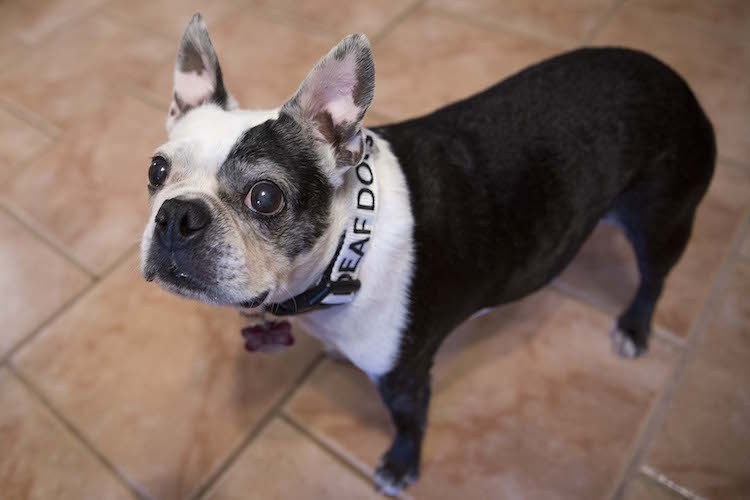
Help A Fearful Dog – An Amazing Journey
Fearful dogs have taught me so much about relationships with dogs, how to interact with dogs, and how to let them interact with me. Every fearful dog I’ve helped has been different. An intervention that worked for one dog needed adjusting for the next one. It is an incredible journey. A hard one, too. It tested my belief in my abilities and it pushed me to seek the best for that dog. All of my fearful dogs were eventually adopted to loving homes that were perfectly suited for them.
Much love and good vibes to you and your journey with your fearful dog. Let me know how things are going.
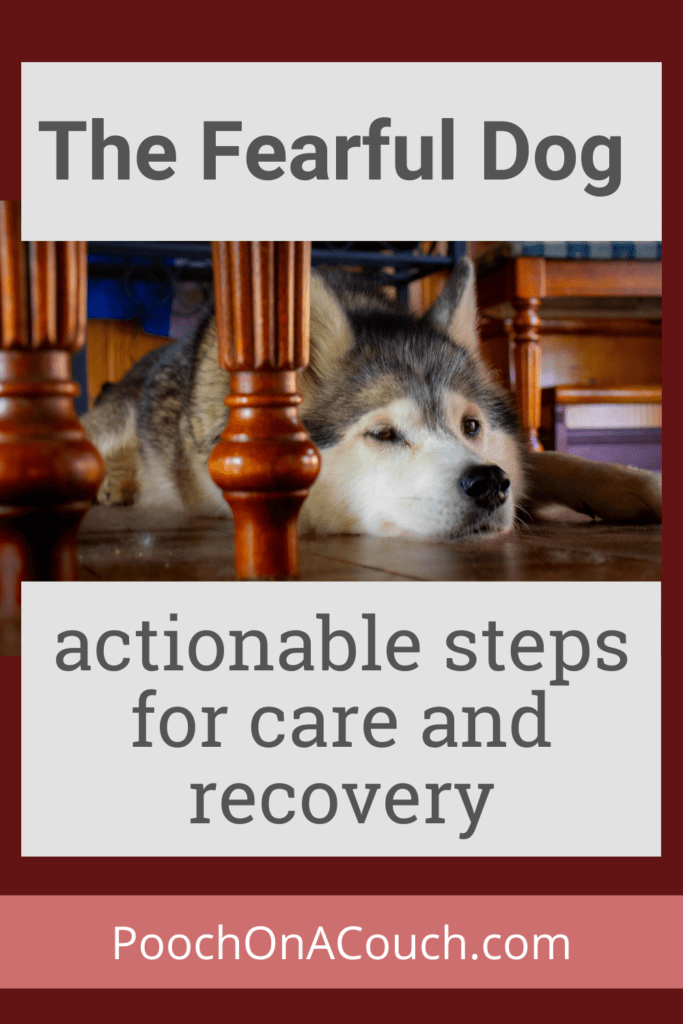
*About Paula Nowak, CPDT-KA, CNWI, CTDI
Paula is the owner, head trainer, and behavioral consultant for Canine Country Academy in Lawrenceville, Georgia. Her training facility and team provide a full array of group classes and private sessions. Since 2020, virtual services have also been added to their repertoire of offerings. Follow her on Youtube for helpful tutorials!
Popular Posts
How To Foster Dogs – 10 Skills You Need To Know
How To Choose A Dog Rescue Agency
Can’t Foster? Volunteer Instead!

